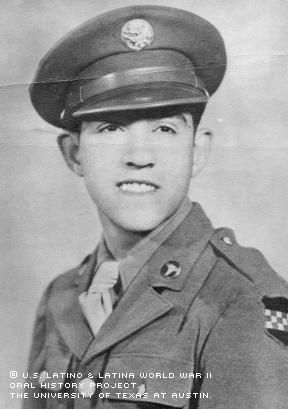
By Elizabeth James
As a medic treating the wounded and dying in World War II, Arthur Tafoya says dealing with the blood and gore of battle was in some ways the easy part. The difficult part was dodging the bullets and artillery fire.
"Artillery and bullets didn't discriminate," Tafoya recalled. "It didn't matter that we had red crosses [on our uniforms]. We were always under fire."
For Tafoya, the war wasn’t a matter of choice: He was 18 and a junior in high school when he was drafted in 1943. And the draft was of little consequence to him, as he believed it was his duty to defend his country.
Tafoya was born Oct. 5, 1924, in Las Vegas, N.M. His father worked as a laborer while his mother was a housewife. Tafoya says he rarely saw his father because he worked long hours to pay for his three sons and four daughters to attend Immaculate Conception, a local Catholic parochial school.
In 1943, Tafoya was sent to Camp Barkeley, near Abilene, Texas, for basic training.
"I did not have any friends there, but there were two other guys there from the same area of New Mexico," said Tafoya, adding that he didn’t have any trouble with the "Anglos" in basic training, with the exception of a few arguments about the statehood of New Mexico.
"A lot of guys did not know history, especially those from the East Coast," Tafoya said. "They did not believe me that New Mexico was part of Old Mexico."
After basic training, Tafoya was sent to England, where he trained for three more weeks in preparation for the invasion of France. He was assigned to the 393d Infantry Regiment, 99th Infantry Division.
"We were on the front line and dealt with injured soldiers on the spot," he said.
A team of medics would rush out onto the battlefield and patch up the wounded soldiers. Tafoya says if they were already dead, they’d take the dog tags off the GIs and leave the bodies for the quartermaster corps troops to come pick up.
"They [quartermasters] would pick them up and throw them in a truck like you throw a pile of wood," Tafoya said.
His company followed the Allied troops as they forced the German army to retreat to Belgium. Tafoya remembers the Germans protecting themselves from tanks by taking cover in "pillboxes," defenses constructed with thick concrete walls. He says the pillboxes, which slept four to five soldiers, held enough food and ammunition to last for long periods of time, and that many GIs were killed trying to capture these strongholds.
One bright spot amidst the carnage was Christmas of 1944, when a hot lunch was offered to the soldiers, Tafoya recalls. The food trucks were parked about 200 yards from the battle action, so the soldiers had to climb out of their foxholes and dodge enemy fire as they ran to retrieve their lunches. He says many soldiers wouldn’t leave their foxholes, fearing enemy gunfire, but that he didn’t care; he wanted the hot lunch.
"We got our turkey," Tafoya said. "I hit the ground I don't know how many times, but I never let go of that turkey."
While in Frankfurt, Germany, Tafoya was injured when a jeep in which he was riding overturned. The injury ended his duty in Europe and he was shipped back to the U.S. in August of 1945.
"I was on the ship ... when we heard that Japan surrendered," Tafoya recalled.
After being discharged Dec. 22, 1945, Technician fifth Class Tafoya attended college, but was unable to concentrate on his studies. He re-enlisted five years after his discharge as a corporal, and eventually served in the Korean War.
For his military service, he earned a Bronze Star, Good Conduct Medal, American Campaign Medal, European-African-Middle Eastern Campaign Medal, Combat Medical Medal and WWII Victory medal.
Tafoya was employed at the Pentagon in the Army Dispensary for three years before moving back to Las Vegas, N.M., where he worked for the state's Las Vegas Medical Center.
His experience as a medic during WWII was put to good use. He started as an attendant and moved up to Manager of the Brain-Retraining Unit, which handled patients who’d received damage to an area of their brain. Tafoya stayed there for 33 years.
Mr. Tafoya was interviewed in Santa Fe, New Mexico, on November 3, 2002, by Norman L. Martinez.

